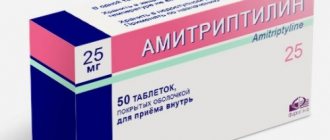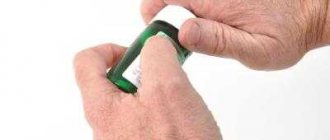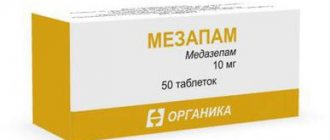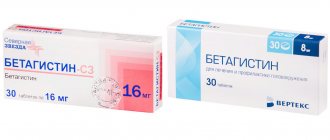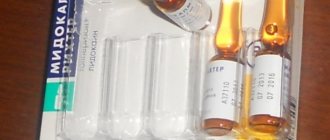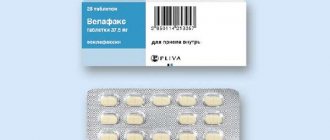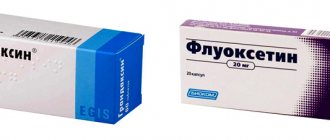Pharmacological properties
The drug Amitriptyline, the instructions for use indicate this, has a strong peripheral and central anticholinergic effect due to its high affinity for m-cholinergic receptors; strong sedative effect associated with affinity for H1-histamine receptors and alpha-adrenergic blocking effect.
It has the properties of a class IA antiarrhythmic drug; like quinidine in therapeutic doses, it slows down ventricular conduction. It has a strong peripheral and central anticholinergic effect due to its high affinity for m-cholinergic receptors; strong sedative effect associated with affinity for H1-histamine receptors and alpha-adrenergic blocking effect.
It has the properties of a class IA antiarrhythmic drug; like quinidine in therapeutic doses, it slows down ventricular conduction (in overdose it can cause severe intraventricular block).
The mechanism of antidepressant action is associated with an increase in the concentration of norepinephrine and/or serotonin in the central nervous system (CNS) (decreasing their reabsorption).
The accumulation of these neurotransmitters occurs as a result of inhibition of their reuptake by the membranes of presynaptic neurons. With long-term use, it reduces the functional activity of beta-adrenergic and serotonin receptors in the brain, normalizes adrenergic and serotonergic transmission, and restores the balance of these systems, disturbed during depressive states.
In anxiety-depressive conditions, it reduces anxiety, agitation and depressive symptoms. The mechanism of antiulcer action is due to the ability to have a sedative and m-anticholinergic effect.
Effectiveness for bedwetting appears to be due to anticholinergic activity leading to increased bladder distensibility, direct beta-adrenergic stimulation, alpha-adrenergic agonist activity leading to increased sphincter tone, and central blockade of serotonin uptake.
It has a central analgesic effect, which is believed to be associated with changes in the concentration of monoamines in the central nervous system, especially serotonin, and an effect on endogenous opioid systems.
The mechanism of action in bulimia nervosa is unclear (may be similar to that in depression). A clear effect of the drug on bulimia has been shown in patients both without depression and in its presence, while a decrease in bulimia can be observed without a concomitant weakening of depression itself.
During general anesthesia, it reduces blood pressure and body temperature. Does not inhibit monoamine oxidase (MAO). The antidepressant effect develops within 2-3 weeks after the start of use.
Analogs
If it is impossible to use the original product, experts prescribe an analogue with a similar composition and therapeutic properties.
The most popular substitutes:
- Doxepin – capsules for oral administration, which contain the substance doxepin hydrochloride. The component, like the active ingredient Amitriptyline, belongs to the group of tricyclic antidepressants, and therefore has a hypnotic, sedative and antidepressant effect. The medication is used for neuroses, manic-depressive states, and neuroses. During pregnancy, lactation and under the age of 12 years, the medication is not used.
- Azafen is a drug based on pipofezin. The component belongs to tricyclic antidepressants and has pronounced sedative properties. Used for neuroses, depression and various neurological disorders accompanied by severe pain. The drug helps eliminate acute symptoms and normalize the patient's condition. The dosage is increased gradually and also gradually reduced to avoid negative reactions during sudden withdrawal. The medicine is contraindicated for diabetes mellitus, severe heart pathologies, and during pregnancy and lactation.
- Mirtazapine is an antidepressant based on the active ingredient of the same name. It has a pronounced sedative and mild hypnotic effect, helps eliminate the symptoms of the disorder and improve the general condition of the patient. Used only according to strict indications, as it can provoke negative reactions. The drug is contraindicated in case of intolerance to its components, during lactation and pregnancy.
Any of the analogues can provoke complications, so it is not used without a doctor’s permission.
Amitriptyline injections, tablets: what does the medicine help with?
According to the instructions, Amitriptyline is prescribed for the treatment of depressive states of involutional, reactive, endogenous, medicinal nature, as well as depression due to alcohol abuse, organic brain damage, accompanied by sleep disturbances, agitation, and anxiety. Indications for the use of Amitriptyline are:
- Chronic pain (migraine, atypical facial pain, pain in cancer patients, post-traumatic and diabetic neuropathy, rheumatic pain, postherpetic neuralgia).
- Schizophrenic psychoses.
- Emotional mixed disorders.
- Behavioral disorders.
- Nocturnal enuresis (except that caused by low bladder tone).
- Bulimia nervosa.
What else do pills help with? Amitriptyline is also used for gastrointestinal ulcers, to relieve headaches and prevent migraines.
Contraindications
Contraindications to the use of the drug in question are:
- decompensated heart defects;
- conduction disorders of the heart muscle;
- acute and recovery period of myocardial infarction;
- acute diseases of the liver and kidneys, with severe dysfunction of these organs;
- exacerbation of peptic ulcer of the stomach and duodenum;
- glaucoma;
- hypersensitivity to the main active ingredient of the drug Amitriptyline, from which these tablets can cause allergies;
- blood diseases;
- paralytic ileus and pyloric stenosis;
- dysfunction of the bladder;
- prostate hypertrophy;
- the use of Amitriptyline in combination with monoamine oxidase inhibitors;
- pregnancy and breastfeeding;
- Children under 6 years of age should not take Amitriptyline tablets, and the drug in injection form can only be prescribed to children over 12 years of age.
Release form and composition
The drug is available in the form of film-coated tablets: biconvex, round, white (50 pieces in dark glass bottles, sealed with a polypropylene cap with first opening control, in a cardboard box one bottle and instructions for use of Amitriptyline Nycomed).
Composition per 1 film-coated tablet:
- active ingredient: amitriptyline – 10 mg or 25 mg (in the form of amitriptyline hydrochloride – 11.3 mg or 28.3 mg);
- auxiliary components of the tablet core: potato starch, magnesium stearate, lactose monohydrate, povidone, microcrystalline cellulose, talc;
- film shell: titanium dioxide, talc, propylene glycol, hypromellose.
Amitriptyline: instructions for use
How to take the pills
Amitriptyline tablets should be swallowed without chewing. The starting dosage for adults is 25-50 mg, take the drug at night. Over the course of 5-6 days, the dosage is increased, brought to 150-200 mg/day, taken in 3 doses. The instructions for Amitriptyline indicate that the dosage is increased to 300 mg/day if no improvement is observed after 2 weeks.
When symptoms of depression have disappeared, the dosage should be reduced to 50-100 mg/day. If the patient's condition does not improve within 3-4 weeks of treatment, further therapy is considered inappropriate. For elderly patients with minor disorders, tablets of the drug are prescribed in a dosage of 30-100 mg/day, taken at night. After improvement of the condition, patients are allowed to switch to a minimum dosage of 25-50 mg/day.
Instructions for use of the solution
The drug is administered intravenously or intramuscularly slowly in a dosage of 20-40 mg 4 times a day. Treatment lasts 6-8 months. The drug for neurological pain (including chronic headaches) and for the prevention of migraines is taken in a dosage of 12.5-100 mg/day. Children 6-10 years old with nocturnal enuresis are given 10-20 mg of the drug per day, at night, children 11-16 years old - 25-50 mg/day. For the treatment of depression in children aged 6-12 years, Amitriptyline is prescribed in a dose of 10-30 mg or 1-5 mg/kg/day, in fractions.
Side effects
After taking the drug, adverse reactions of the body may occur that require discontinuation of the drug or reduction of its dose:
- dry mouth;
- nausea;
- allergic reactions: bronchospasm, skin rash;
- diarrhea;
- sleep disorders;
- urinary retention;
- visual disturbances.
The instructions for the drug contain information that long-term use of the drug may increase body weight and enlarge the lymph nodes.
Interaction
A hypotensive effect, respiratory depression, and a depressant effect on the nervous system are observed with the joint prescription of medications that depress the central nervous system: general anesthetics, benzodiazepines, barbiturates, antidepressants and others.
The drug enhances the severity of the anticholinergic effect when taking amantadine, antihistamines, biperiden, atropine, antiparkinsonian drugs, phenothiazine. The drug enhances the anticoagulant activity of indadione, coumarin derivatives, and indirect anticoagulants.
There is a decrease in the effectiveness of alpha-blockers and phenytoin. Fluvoxamine and fluoxetine increase the concentration of the drug in the blood. The risk of developing epileptic seizures increases, and the central anticholinergic and sedative effects also increase when combined with benzodiazepines, phenothiazines, and anticholinergics.
Simultaneous administration of methyldopa, reserpine, betanidine, guanethidine, clonidine reduces the severity of their hypotensive effect. When taking cocaine, arrhythmia develops. Delirium develops when taking acetaldehydrogenase inhibitors, disulfiram.
Amitriptyline enhances the effects of phenylephrine, norepinephrine, epinephrine, and isoprenaline on the cardiovascular system. The risk of hyperpyrexia increases when taking antipsychotics and m-anticholinergics.
special instructions
Before carrying out therapy, monitoring blood pressure levels is mandatory. Parenteral Amitriptyline is administered exclusively under the supervision of a physician in a hospital setting. In the first days of treatment it is necessary to observe bed rest. A complete abstinence from ethanol intake is required. Abrupt refusal of therapy can cause withdrawal syndrome.
The drug at a dose of more than 150 mg per day leads to a decrease in the threshold of convulsive activity, which is important to consider when developing epileptic seizures in patients with a predisposition. It is possible to develop hypomanic or manic states in persons with cyclical, affective disorders during the depressive phase.
If necessary, treatment is resumed with small doses after relief of these conditions. Caution should be exercised when treating patients with thyrotoxicosis when treating individuals taking thyroid hormone medications due to the possible risk of cardiotoxic effects.
The medication can provoke the development of paralytic intestinal obstruction in elderly people, as well as those prone to chronic constipation. It is imperative to warn anesthesiologists about taking amitriptyline before performing local or general anesthesia.
Long-term therapy provokes the development of caries. The need for riboflavin may increase. Amitriptyline passes into breast milk and causes increased drowsiness in infants. The medication affects driving.

